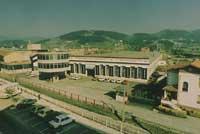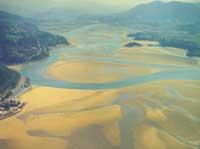An exaggerated project
Introduction to the Urdaibai Plan

In 1984, UNESCO declared the region of Urdaibai as “Biosphere Reserve” and in 1989 the Urdaibai Protection and Management Law was passed in order to protect its natural resources. Faced with this special situation, the Department of Environment of the Basque Government requested that environmental audits or eco-audits be conducted in most industries in the Gernika area.
Therefore, an audit began in different companies to know in detail the situation of each of them, analyzing the production process, the raw materials used, the exhausted materials and the characteristics and destination of the generated waste. The data provided by the inspection were used for the study of minimization measures in the origin of industrial waste and emissions and for the drafting of the Waste Minimization and Management Plan. This plan, drafted and coordinated by IHOBE, was subsidized by the call for the LIFE program of 1994.
In addition, it offered the possibility of testing new technologies not extended. Among the technologies investigated are some of great interest such as the recovery of metal from galvanic emissions in salts or metals, or the so-called land-farming for the treatment of organic waste.
The Plan addresses two distinct areas: waste minimization and waste management.
Waste minimization
Planning to achieve waste minimization has been divided into three phases: first, see what can be done to reduce waste and prevent it from being so dangerous; then take action and integrate it into industries and finally, control and track the improvements implemented. For the analysis of each part of the production process, the collaboration and opinion of experts in degreasing, pickling or galvanic coating and machining has been counted. The close collaboration of business managers and technicians has also been necessary for the good development of work.

In total, 17 companies from 4 municipalities in the Gernika area (Gernika, Forua, Muxika and Ajangiz) have participated in the plan: armeros, manufacturers of wooden conglomerates, manufacturers of stainless steel equipment, with different finishes (painted, chromed, etc. ), electric machines, thermal treatments, etc. Almost all these companies decided to follow the recommendations derived from the audit and start implementing preventive measures, new technologies or new forms of production.
Although these words seem to be an expression of great things, changes in industries are more based on good practices than on the implementation of new technologies. Therefore, we must recognize discreetly the achievements obtained in waste reduction.
Waste management in Urdaibai
The Urdaibai Plan also develops a project to achieve adequate waste management in southern Urdaibai industries. Management takes place in three main areas: selective collection, accumulation parks and pilot experiences. Waste becomes untreatable when different types are mixed. Therefore, each company designs a selective collection plan. Accumulation parks located outside production areas are also designed. These parks have the function of retaining waste in due conditions during the search of the waste manager. This ensures the correct separation of waste and the non-emission of pollutants. Finally, pilot residue treatment experiences are launched as the “soft” biological method for the treatment of organic substances such as fats, sawdust, oiled rags, etc.
Awareness in companies is the main result obtained
The implications of innovations and technologies implemented in workshops and companies are currently being analyzed. This data will be compared with the situation of 1992, that is, with the data of the time the audits were performed, and some conclusions will be drawn. From there the project coordinators have not wanted to move forward. On the contrary, IHOBE is instructed to publish a monograph with global conclusions and some individual experiences of interest.
In general, they recognize that it has been a partial success, since a number of measures have been implemented, although others have been annulled by economic and/or technical barriers. It seems that the greatest success is due to a change of consciousness regarding the business environment: in the beginning companies had no consideration with the environment, but today it is becoming an important factor that they remember in their everyday projects. There is something to start walking, but will it be enough to solve Urdaibai's serious pollution problems?
Buletina
Bidali zure helbide elektronikoa eta jaso asteroko buletina zure sarrera-ontzian











